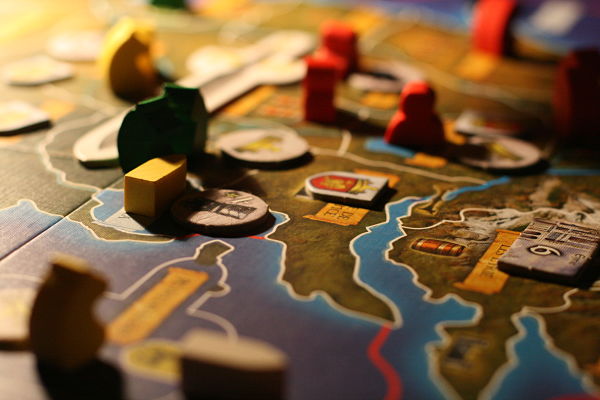How Do You (Successfully) Gamify a Course?
Much like a token on a board game, Mika LaVaque-Manty took a circuitous yet constrained path to becoming a professor of political science. While his own father in Finland was professor of architecture – “so I had a sense of what it meant to be a nerd” – he wasn’t sure he wanted to be a professor, much less a political scientist. When he came to the U.S. in 1986 to attend college, he studied philosophy and was on his way to getting a doctorate in that, even though, he admits, “I had always liked the somewhat more concrete approach of empirical social science.” So with his freshly minted Ph.D., he rolled the dice and applied for jobs in both philosophy and political science … and poli sci won when that department at the University of Washington offered him a job.
Now an associate professor of political science at the University of Michigan, LaVaque-Manty has drawn raves for how he promotes student engagement and autonomy in the courses he teaches by “gamifying” the proceedings – a point-based system that draws on pedagogic techniques like metacognition, self-regulated learning and, well, fun, that gives students a chance to learn in a friendly and less stressful manner that still challenging. It’s not about playing games per se – or gaming the education system, either – but it does “draw on their logic,” he explains.
This week LaVaque-Manty is receiving the 2014 CQ Press Award for Teaching Innovation in Political Science at the annual meeting of the American Political Science Association. (Judges were Victor Asal at University at Albany, SUNY; Michelle Deardorff, University of Tennessee at Chattanooga; and Renee Van Vechten, University of the Redlands.)
Our friends at SAGE Connection caught up with LaVaque-Manty shortly before he left for Washington, D.C., and the following is part of their conversation:
Can you explain what “gamification” means?
“Gamification” draws from the world of games — video games, board games, sports — and applies their logic to practices we don’t usually think of in terms of games. In teaching and learning, it means allowing multiple paths to achievement (not everybody has to do the same assignments), safe failures (let’s allow students to practice the assignment instruments we impose on them before making them high stakes), and “leveling up” instead of “getting points taken off.”
In some circles, “gamification” is already a bad word because, critics say, it’s about manipulation. For example, frequent flyer miles, an old form of gamification, is about getting you to be loyal to one airline. I don’t really care what we call these practices; my point is that they don’t have to be manipulative. I am most interested in student motivation and student autonomy. All grading and assignment schemes, one could argue, are manipulative in the sense that they try to get students to act in certain ways. I think gamification offers better incentives than our conventional approaches. Or, as some people put it, college is already a game — it’s just a poorly designed one.
I should also say that for me, at least, it is important to open the hood of our pedagogical practices: I explain to the students why we are doing what we are doing.
How did you gamify your course?
The course I have most thoroughly and longest gamified is my Intro to Political Theory. At Michigan, it’s one of the four poli sci intro courses, but because it’s called POLSCI 101, students often think they’ll get to talk about Obamacare or Ukraine or the Arab Spring, and instead they get Plato and Hobbes. It was in part to counter their bewilderment and frustration that I started introducing optional elements such as blogging and group projects. So, the first big gamified element was the idea of multiple paths to achievement. There are, of course, some things all students are expected to do — read the texts, go to lecture and discussion section — but for the bigger assignments, students get to choose from among a menu: they can write conventional essays, they can blog, or they can find a couple of other students with whom to come up with a group project. And they have to decide what the project is going to be. We give them examples: websites, posters, podcasts, videos. But we don’t require any particular format, and the first group that proposed a board game way back in 2009, for example, was really brilliant.
The idea with these optional paths is to invite students to think about how these weird readings from 2000 years ago might be relevant now and also to have them leverage interests or skills they have but didn’t think were pertinent to political theory. For example, when you write a song about Machiavelli and record it because you are a voice major, you’ll get to think about the material in new way, do something you like and — I will argue — understand Machiavelli much better than you would have if you had to take another blue-book exam about him.
…As a student, 60 percent of your course grade’s weights are up to you. You might be interested in a group project but think it’s a bit risky, while you know you can write papers pretty solidly. Fine: do both, and weight the group project lightly and the papers heavily. Your call!
So, optional paths were the first big thing. The second was the grading scheme. Students start with zero points — an F as a course grade! — and acquire points. We are trying to get them away from the common idea that when you don’t get an A on an assignment, you have “points taken off.” Instead, anything you do gets you some points. If you do it well, you get lots of points. If you fumble, well, you still got some points, and you eventually will “level up.”
The most unusual element in my grading scheme is that in addition to getting to choose some of their assignments, the students get to decide how they want to weight them. The way I do it in practice is pretty complicated, but the idea is that as a student, 60 percent of your course grade’s weights are up to you. You might be interested in a group project but think it’s a bit risky, while you know you can write papers pretty solidly. Fine: do both, and weight the group project lightly and the papers heavily. Your call! Of course, we don’t make the students do this in a vacuum: they can try very low-stakes versions of each assignment type early and get feedback on them.
In addition to motivating differently, the leveling up model tries to realize another important element in games: safe failures. In a standard course, most of the assignments tend to be pretty high stakes: you mess up on this midterm exam, and your grade suffers. The conventional approach to student assessment has made the most important component of learning — failing at first — too risky. With the leveling up model, we try to reduce the stakes of any given assignment. Of course, there are opportunity costs to the students, so “failures” are not completely safe. And my desire not to exploit my graduate student instructors keeps me from allowing endless repeats of assignments. But it’s better, in terms of student motivation, satisfaction, and effort than the conventional approach I used in the course before 2009.
How was this received by the students? How was it received by your colleagues or other course instructors?
How do I know? I asked them. I got a small grant last year to study the effects of this approach. Among other things, I surveyed all the students who had taken this gamified course and the last iteration of the conventional one, back in 2007. That was a total of 1,600 students; we got a decent 40 percent response rate, even from the 2007 cohort, which was pretty impressive. Students generally really appreciated the autonomy-fostering elements of the course — after the fact. Other surveys I and colleagues have done during the semesters suggest that students are, at first, freaked out by the responsibility they have for their grade, but once they figure it out, they love it. A majority of them [that is]; not everybody likes the approach at all. Sometimes the students who look like the best students on paper don’t. After all, they have gotten very good at playing the bad game of college, and here we’re giving them a new one.
My colleagues and other instructors are generally appreciative and interested in my approach, at least to my face. My graduate student instructors have been the best sports about it, even when some new experiment hasn’t worked as well as it might have. Lots of folks at the University of Michigan have expressed interest and several have gamified courses in the way I do. Interestingly, most of them have been outside political science, for better or for worse: astronomy, music, freshman comp. Some political science colleagues have incorporated elements from my approach, and they generally say they have been happy about it.
What did you learn from the experience?
I’ve already hinted at some of the things I’ve learned, most importantly that students arguably benefit from it and definitely find it rewarding. I’ve also learned that it takes some experimentation to get things right. (I’m also sure I haven’t gotten everything right.) I have learned that just changing a grading scheme into a point system is meaningless. The disparaging phrase is “pointsification.” It doesn’t do anything to the underlying pedagogical structure, and it turns students into point hogs in the worst possible way.
I’ve also learned that if you change your assessment or grading scheme, change it so significantly that people won’t interpret it in terms of a conventional system. For example, it doesn’t help to make an assignment worth 1,000 points or a million — if it’s divisible by 10, your students and your graduate student instructors will think in terms of the conventional 100-point scale. I have also learned that it is important to open the hood, as I said, and keep educating your students about the system. That might seem like a distraction from the course substance, but if your goal is, as mine is, to encourage students thinking of themselves as learners — metacognition, that is — then it’s actually a good thing.
What advice would you give to professors with similar ambitions for improving the classroom experience?
This segues nicely to advice to others. My course is thoroughly different from what it was from 2002 to 2007, but it’s taken five years to get here. My first recommendation is to start small and focused: think about one or two things you’d want to change. And, most importantly, think about why you want to do something. Pedagogical techniques are like new technologies: they often look cool. They can be cool, and I am also a big fan of IT innovation in teaching. But don’t do or use something just because it seems cool. It has to make sense for your pedagogical goals.
The good thing, though, is that a lot of instructors don’t really think about what their pedagogical goals are, and considering a change can force you to get more precise about what you really want your students to get out of your courses.
The other piece of advice I would give is that plan as thoroughly as possible and then be prepared for lots of unanticipated things, anyway. As my international relations colleagues know, no battle plan survives a contact with the enemy. Our students are not enemies, but the principle applies. At the same time, without a plan, you will not survive.






























































































Wonderful. Here is the problem. The time it would take to implement this is prohibitive for most professors. Research, papers at conferences, grants, and refereed publications are the ONLY way to get tenure and promotion.
So what we need is gaming apps for political science that professors can download and use. Plug-and-play.
Imagine what the world would be like if every person had to create their own custom version of Facebook or Twitter. This whole ramification needs to be “commercialized” and the sooner the better.